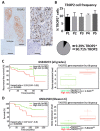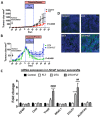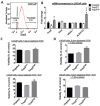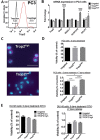High expression of TROP2 characterizes different cell subpopulations in androgen-sensitive and androgen-independent prostate cancer cells
- PMID: 27283984
- PMCID: PMC5190113
- DOI: 10.18632/oncotarget.9876
High expression of TROP2 characterizes different cell subpopulations in androgen-sensitive and androgen-independent prostate cancer cells
Abstract
Progression of castration-resistant tumors is frequent in prostate cancer. Current systemic treatments for castration-resistant prostate cancer only produce modest increases in survival time and self-renewing Tumor-Initiating Cells (TICs) are suspected to play an important role in resistance to these treatments. However it remains unclear whether the same TICs display both chemo-resistance and self-renewing abilities throughout progression from early stage lesions to late, castration resistant tumors. Here, we found that treatment of mice bearing LNCaP-derived xenograft tumors with cytotoxic (docetaxel) and anti-androgen (flutamide) compounds enriched for cells that express TROP2, a putative TIC marker. Consistent with a tumor-initiating role, TROP2high cells from androgen-sensitive prostate cancer cell lines displayed an enhanced ability to re-grow in culture following treatment with taxane-based chemotherapy with or without androgen blockade. TROP2 down-regulation in these cells reduced their ability to recur after treatment with docetaxel, in the presence or absence of flutamide. Accordingly, in silico analysis of published clinical data revealed that prostate cancer patients with poor prognosis exhibit significantly elevated TROP2 expression level compared to low-risk patients, particularly in the case of patients diagnosed with early stage tumors. In contrast, in androgen-independent prostate cancer cell lines, TROP2high cells did not exhibit a differential treatment response but were characterized by their high self-renewal ability. Based on these findings we propose that high TROP2 expression identifies distinct cell sub-populations in androgen-sensitive and androgen-independent prostate tumors and that it may be a predictive biomarker for prostate cancer treatment response in androgen-sensitive tumors.
Keywords: TROP2; prostate cancer; self-renewal; treatment resistance.
Conflict of interest statement
The authors declare no conflict of interest.
Figures
Similar articles
-
Trop2 is a driver of metastatic prostate cancer with neuroendocrine phenotype via PARP1.Proc Natl Acad Sci U S A. 2020 Jan 28;117(4):2032-2042. doi: 10.1073/pnas.1905384117. Epub 2020 Jan 13. Proc Natl Acad Sci U S A. 2020. PMID: 31932422 Free PMC article.
-
BMI-1 Targeting Interferes with Patient-Derived Tumor-Initiating Cell Survival and Tumor Growth in Prostate Cancer.Clin Cancer Res. 2016 Dec 15;22(24):6176-6191. doi: 10.1158/1078-0432.CCR-15-3107. Epub 2016 Jun 15. Clin Cancer Res. 2016. PMID: 27307599 Free PMC article.
-
Androgens modify therapeutic response to cabazitaxel in models of advanced prostate cancer.Prostate. 2020 Sep;80(12):926-937. doi: 10.1002/pros.24015. Epub 2020 Jun 16. Prostate. 2020. PMID: 32542812 Free PMC article.
-
Exploitation of the Androgen Receptor to Overcome Taxane Resistance in Advanced Prostate Cancer.Adv Cancer Res. 2015;127:123-58. doi: 10.1016/bs.acr.2015.03.001. Epub 2015 Mar 29. Adv Cancer Res. 2015. PMID: 26093899 Review.
-
Improving Taxane-Based Chemotherapy in Castration-Resistant Prostate Cancer.Trends Pharmacol Sci. 2016 Jun;37(6):451-462. doi: 10.1016/j.tips.2016.03.003. Epub 2016 Apr 8. Trends Pharmacol Sci. 2016. PMID: 27068431 Review.
Cited by
-
Trop2: Jack of All Trades, Master of None.Cancers (Basel). 2020 Nov 11;12(11):3328. doi: 10.3390/cancers12113328. Cancers (Basel). 2020. PMID: 33187148 Free PMC article. Review.
-
Overexpression of the Pluripotent Stem Cell Marker Podocalyxin in Prostate Cancer.Anticancer Res. 2018 Nov;38(11):6361-6366. doi: 10.21873/anticanres.12994. Anticancer Res. 2018. PMID: 30396958 Free PMC article.
-
The role of Trop2 in prostate cancer: an oncogene, biomarker, and therapeutic target.Am J Clin Exp Urol. 2021 Feb 15;9(1):73-87. eCollection 2021. Am J Clin Exp Urol. 2021. PMID: 33816696 Free PMC article.
-
Single-sEV profiling identifies the TACSTD2 + sEV subpopulation as a factor of tumor susceptibility in the elderly.J Nanobiotechnology. 2024 May 3;22(1):222. doi: 10.1186/s12951-024-02456-x. J Nanobiotechnology. 2024. PMID: 38698420 Free PMC article.
-
Association of tumor TROP2 expression with prognosis varies among lung cancer subtypes.Oncotarget. 2017 Apr 25;8(17):28725-28735. doi: 10.18632/oncotarget.15647. Oncotarget. 2017. PMID: 28404926 Free PMC article.
References
-
- Obertova Z, Brown C, Holmes M, Lawrenson R. Prostate cancer incidence and mortality in rural men--a systematic review of the literature. Rural Remote Health. 2012;12:2039. - PubMed
-
- Sakr WA, Grignon DJ, Crissman JD, Heilbrun LK, Cassin BJ, Pontes JJ, Haas GP. High grade prostatic intraepithelial neoplasia (HGPIN) and prostatic adenocarcinoma between the ages of 20-69: an autopsy study of 249 cases. In Vivo. 1994;8:439–443. - PubMed
-
- Trewartha D, Carter K. Advances in prostate cancer treatment. Nat Rev Drug Discov. 2013;12:823–824. - PubMed
-
- Ni J, Cozzi P, Hao J, Duan W, Graham P, Kearsley J, Li Y. Cancer stem cells in prostate cancer chemoresistance. Curr Cancer Drug Targets. 2014;14:225–240. - PubMed
-
- Liu C, Li Z, Bi L, Li K, Zhou B, Xu C, Huang J, Xu K. NOTCH1 signaling promotes chemoresistance via regulating ABCC1 expression in prostate cancer stem cells. Mol Cell Biochem. 2014;393:265–270. - PubMed
MeSH terms
Substances
LinkOut - more resources
Full Text Sources
Other Literature Sources
Medical
Research Materials
Miscellaneous






